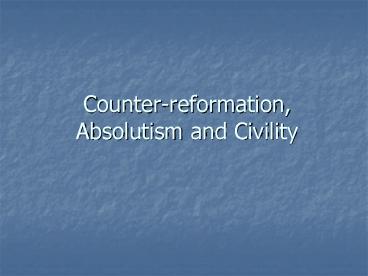Counterreformation, Absolutism and Civility - PowerPoint PPT Presentation
1 / 11
Title:
Counterreformation, Absolutism and Civility
Description:
Louis XIII and Louis XIV increasingly hostile ... mass emigration of Protestants. rise in efforts by the Church to impose its values of godliness through the ... – PowerPoint PPT presentation
Number of Views:194
Avg rating:3.0/5.0
Title: Counterreformation, Absolutism and Civility
1
Counter-reformation, Absolutism and Civility
2
Counter-reformation
- 1598 Henri IV Edict of Nantes
- Louis XIII and Louis XIV increasingly hostile
toward the Protestants - destruction of 6-700 Protestant churches
- Edict of Fontainebleau (1685) Louis XIV
- mass emigration of Protestants
- rise in efforts by the Church to impose its
values of godliness through the villages priests
(cures) and the devouts (dévots).
3
Absolutism
- In 17th-century France provided a model for
absolutism that influenced other countries in
Europe. - Based on Divine Right King represents the
Christian gods wishes healing powers - Cardinal Richelieu "one law, one faith, one
king." - Fight against revolts against the crown 1650 the
Fronde (Louis XIV a child)
4
Louis XIVs reign
- personal reign was from 1661 to 1715
- personification of absolutism
- the Sun King
- highly centralized power
- lettres de cachet (royal arrest warrants)
- development of a patriarchal society
- Académie Française founded by Richelieu
- made luxury a virtue
5
Versailles
- Moved the court to Versailles 1682
- All roads converged on his bedroom as spokes on a
wheel - Ostentatious
- Canals, Hall of Mirrors
- Nobility resided there
6
Civility
- "courtliness" latter Middle Ages aristocratic
code of behavior personal honor, courage,
self-sacrifice - slow extinction of the knightly-feudal warrior
and the formation of a new court aristocracy in
the 16th and 17th centuries, the concept of
"civility" slowly takes hold and this word comes
to replace the word "courtliness"
7
Civility defined
- "Civility" means "honesty", "affability" or
"sociability" and "decency". - More bourgeois than courtly. Reflect the
assimilation of the bourgeoisie into the
aristocracy wealthy bourgeois merchants at this
time bought titles of nobility and became part of
the aristocracy.
8
Erasmus of Rotterdam (1466 - 1536)
- Dutch humanist and theologian.
- Criticized the Church.
- Inspired Martin Luther and the Reformation.
- Author of Manners for Children (1530).
9
Erasmus, Manners for Children (1530)
- Reformulated the notion of civility, drawing on
texts from ancient Greece Rome, the Middle
Ages, and folk wisdom. - Set the tone for manners guides over the next 3
centuries. - Gave advice to children regarding social
situations church, dining, meetings, gambling,
going to bed. - Argues that physical signs (gestures, mimicry,
postures) express a persons inner state. - Believes in the childs natural goodness.
- Proposes a code of conduct valid for everyone.
- Assumes that civility can be taught.
10
Jean-Baptiste de la Salle (1651 - 1719)
- French priest and educational reformer.
- Founded charity schools in Lyon in 1679, for poor
urban children. - Author of Rules of Propriety and Christian
Civility (1703).
11
La Salle, Rules of Propriety and Christian
Civility (1703)
- Follows the Erasmian model, but authoritarian in
structure. - Dwells on modesty of bodily posture and
behaviors, providing detailed instructions for
every bodily pose. - The body must be effaced as much as possible.
- The body must remain hidden, even in private, and
even from ones own eyes.






























